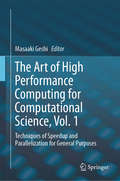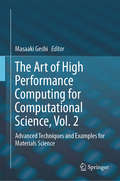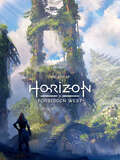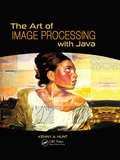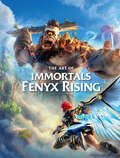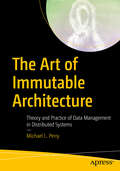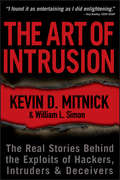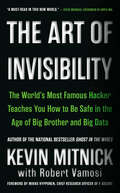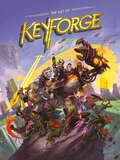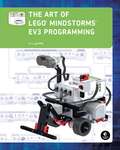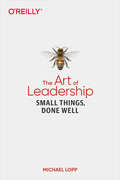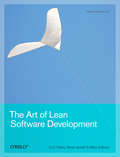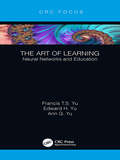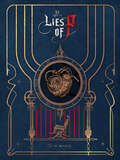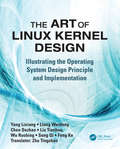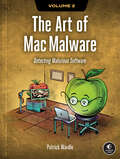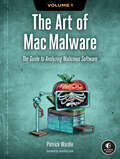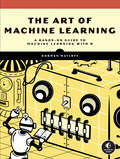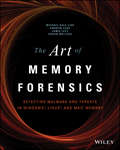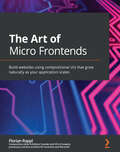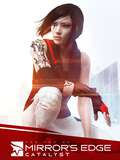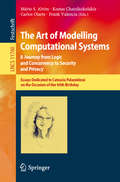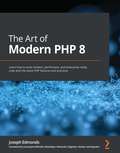- Table View
- List View
The Art of High Performance Computing for Computational Science, Vol. 1: Techniques of Speedup and Parallelization for General Purposes
by Masaaki GeshiThis book provides basic and practical techniques of parallel computing and related methods of numerical analysis for researchers who conduct numerical calculation and simulation. Although the techniques provided in this book are field-independent, these methods can be used in fields such as physics, chemistry, biology, earth sciences, space science, meteorology, disaster prevention, and manufacturing. In particular, those who develop software code in these areas will find this book useful. The contents are suitable for graduate students and researchers in computational science rather than novices at programming or informed experts in computer science.Starting with an introduction to the recent trends in computer architecture and parallel processing, Chapter 1 explains the basic knowledge of speedup programs with simple examples of numerical computing. Chapters 2 – 4 detail the basics of parallel programming, the message passing interface (MPI), and OpenMP and discuss hybrid parallelization techniques. Showing an actual example of adaptation, Chapter 5 gives an overview of performance tuning and communication optimizations. To deal with dense matrix calculations, Chapter 6 details the basics and practice of linear algebra calculation libraries BLAS and LAPACK, including some examples that can be easily reproduced by readers using free software. Focusing on sparse matrix calculations, Chapter 7 explains high performance algorithms for numerical linear algebra. Chapter 8 introduces the fast Fourier transform in large-scale systems from the basics. Chapter 9 explains optimization and related topics such as debug methods and version control systems. Chapter 10 discusses techniques for increasing computation accuracy as an essential topic in numerical calculation. This is the first of the two volumes that grew out of a series of lectures in the K computer project in Japan. The second volume will focus on advanced techniques and examples of applications in materials science.
The Art of High Performance Computing for Computational Science, Vol. 2: Advanced Techniques and Examples for Materials Science
by Masaaki GeshiThis book presents advanced and practical techniques for performance optimization for highly parallel processing. Featuring various parallelization techniques in material science, it is a valuable resource for anyone developing software codes for computational sciences such as physics, chemistry, biology, earth sciences, space science, weather, disaster prevention and manufacturing, as well as for anyone using those software codes.Chapter 1 outlines supercomputers and includes a brief explanation of the history of hardware. Chapter 2 presents procedures for performance evaluation, while Chapter 3 describes the set of tuned applications in materials science, nanoscience and nanotechnology, earth science and engineering on the K computer. Introducing the order-N method, based on density functional theory (DFT) calculation, Chapter 4 explains how to extend the applicability of DFT to large-scale systems by reducing the computational complexity. Chapter 5 discusses acceleration and parallelization in classical molecular dynamics simulations, and lastly, Chapter 6 explains techniques for large-scale quantum chemical calculations, including the order-N method. This is the second of the two volumes that grew out of a series of lectures in the K computer project in Japan. The first volume addresses more basic techniques, and this second volume focuses on advanced and concrete techniques.
The Art of Horizon Forbidden West
by Guerrilla GamesA dynamic full-color hardcover featuring concept art and creator commentary chronicling the development of the next adventure in the epic Horizon saga.When a mysterious red blight threatens to strangle all life, the heroic young Aloy must tackle new dangers in the mysterious frontier of the Forbidden West in order to save her world. The highly anticipated sequel to Horizon Zero Dawn has finally arrived, and with it, all new vibrant landscapes, jaw-dropping machines, and thrilling secrets to discover. Follow Aloy on her next adventure with this beautiful chronicle created by Dark Horse Books in association with Guerrilla Games! The Art of Horizon Forbidden West uncovers the mysteries of a lost world with all new behind-the-scenes artwork and intimate developer commentary. Relive the unforgettable tale.
The Art of Image Processing with Java
by Kenny A. HuntThis introductory image processing text is ideal for college students studying computer science or software engineering. With an emphasis on software design, the text builds on an accessible mathematical foundation and on extensive sample Java code to teach students the fundamentals of image processing. The text is accompanied by rich illustrations that demonstrate the results of performing processing on famous art pieces. This approach gives readers real-world examples of ways they may use image processing. Each chapter includes problems for students, and an online supplement offers instructor resources.
The Art of Immortals: Fenyx Rising
by UbisoftA fanciful full-colored tome chronicling the development of the hotly anticipated video game Immortals Fenyx Rising(TM) from Ubisoft EntertainmentThe creative team of Ubisoft Quebec presents a fantastical world based on mythological tales, rife with creatures such as bestial minotaur, gigantic cyclops, evil chimera, ferocious harpies, and the terrifying Medusa. This volume offers an inside look at the craft behind that massive and magical land, wherein readers will find themselves taking part in a heroic journey that spans the lush paradisiacal lands of Aphrodite the goddess of love, through the scarred battlefield and fortress of Ares the god of war, up Mount Olympus--home of the mighty Zeus, down into the darkest corners of the underworld. and much more! Not only does this book lend insights into designs of Fenyx, a new winged Greek hero, with their legendary weapons and armor, but also the environments that players will explore, the creatures they will encounter and--most importantly--the gods themselves, who seek aid against the fearsome titan and father of all monsters, Typhon! The Art of Immortals Fenyx Rising gives readers unique insights into the masterful development of a memorable gaming experience. This collection of concept art and creator commentary is sure to engage any fan of games, art, or ancient myth!
The Art of Immutable Architecture: Theory and Practice of Data Management in Distributed Systems
by Michael L. PerryThis book teaches you how to evaluate a distributed system from the perspective of immutable objects. You will understand the problems in existing designs, know how to make small modifications to correct those problems, and learn to apply the principles of immutable architecture to your tools.Most software components focus on the state of objects. They store the current state of a row in a relational database. They track changes to state over time, making several basic assumptions: there is a single latest version of each object, the state of an object changes sequentially, and a system of record exists.This is a challenge when it comes to building distributed systems. Whether dealing with autonomous microservices or disconnected mobile apps, many of the problems we try to solve come down to synchronizing an ever-changing state between isolated components. Distributed systems would be a lot easier to build if objects could not change.After reading The Art of Immutable Architecture, you will come away with an understanding of the benefits of using immutable objects in your own distributed systems. You will learn a set of rules for identifying and exchanging immutable objects, and see a collection of useful theorems that emerges and ensures that the distributed systems we build are eventually consistent. Using patterns, you will find where the truth converges, see how changes are associative, rather than sequential, and come to feel comfortable understanding that there is no longer a single source of truth. Practical hands-on examples reinforce how to build software using the described patterns, techniques, and tools. By the end, you will possess the language and resources needed to analyze and construct distributed systems with confidence. The assumptions of the past were sufficient for building single-user, single-computer systems. But as we expand to multiple devices, shared experiences, and cloud computing, they work against us. It is time for a new set of assumptions. Start with immutable objects, and build better distributed systems.What You Will LearnEvaluate a distributed system from the perspective of immutable objects Recognize the problems in existing designs, and make small modifications to correct them Start a new system from scratch, applying patterns Apply the principles of immutable architecture to your tools, including SQL databases, message queues, and the network protocols that you already use Discover new tools that natively apply these principles Who This Book Is ForSoftware architects and senior developers. It contains examples in SQL and languages such as JavaScript and C#. Past experience with distributed computing, data modeling, or business analysis is helpful.
The Art of Immutable Architecture: Theory and Practice of Data Management in Distributed Systems
by Michael L. PerryThis book teaches you how to evaluate a distributed system from the perspective of immutable objects. You will understand the problems in existing designs, know how to make small modifications to correct those problems, and learn to apply the principles of immutable architecture to your tools.Most software components focus on the state of objects. They store the current state of a row in a relational database. They track changes to state over time, making several basic assumptions: there is a single latest version of each object, the state of an object changes sequentially, and a system of record exists.This is a challenge when it comes to building distributed systems. Whether dealing with autonomous microservices or disconnected mobile apps, many of the problems we try to solve come down to synchronizing an ever-changing state between isolated components. Distributed systems would be a lot easier to build if objects could not change.After reading The Art of Immutable Architecture, you will come away with an understanding of the benefits of using immutable objects in your own distributed systems. You will learn a set of rules for identifying and exchanging immutable objects, and see a collection of useful theorems that emerges and ensures that the distributed systems you build are eventually consistent. Using patterns, you will find where the truth converges, see how changes are associative, rather than sequential, and come to feel comfortable understanding that there is no longer a single source of truth. Practical hands-on examples reinforce how to build software using the described patterns, techniques, and tools. By the end of the book, you will possess the language and resources needed to analyze and construct distributed systems with confidence. The assumptions of the past were sufficient for building single-user, single-computer systems. But aswe expand to multiple devices, shared experiences, and cloud computing, they work against us. It is time for a new set of assumptions. Start with immutable objects, and build better distributed systems.What You Will LearnEvaluate a distributed system from the perspective of immutable objects Recognize the problems in existing designs, and make small modifications to correct them Start a new system from scratch, applying patternsApply the principles of immutable architecture to your tools, including SQL databases, message queues, and the network protocols that you already use Discover new tools that natively apply these principles Who This Book Is ForSoftware architects and senior developers. It contains examples in SQL and languages such as JavaScript and C#. Past experience with distributed computing, data modeling, or business analysis is helpful.
The Art of Intrusion
by Kevin D. Mitnick William L. SimonHacker extraordinaire Kevin Mitnick delivers the explosive encore to his bestselling The Art of DeceptionKevin Mitnick, the world's most celebrated hacker, now devotes his life to helping businesses and governments combat data thieves, cybervandals, and other malicious computer intruders. In his bestselling The Art of Deception, Mitnick presented fictionalized case studies that illustrated how savvy computer crackers use "social engineering" to compromise even the most technically secure computer systems. Now, in his new book, Mitnick goes one step further, offering hair-raising stories of real-life computer break-ins-and showing how the victims could have prevented them. Mitnick's reputation within the hacker community gave him unique credibility with the perpetrators of these crimes, who freely shared their stories with him-and whose exploits Mitnick now reveals in detail for the first time, including: A group of friends who won nearly a million dollars in Las Vegas by reverse-engineering slot machinesTwo teenagers who were persuaded by terrorists to hack into the Lockheed Martin computer systemsTwo convicts who joined forces to become hackers inside a Texas prisonA "Robin Hood" hacker who penetrated the computer systems of many prominent companies-andthen told them how he gained accessWith riveting "you are there" descriptions of real computer break-ins, indispensable tips on countermeasures security professionals need to implement now, and Mitnick's own acerbic commentary on the crimes he describes, this book is sure to reach a wide audience-and attract the attention of both law enforcement agencies and the media.
The Art of Invisibility: The World's Most Famous Hacker Teaches You How to Be Safe in the Age of Big Brother and Big Data
by Kevin MitnickBe online without leaving a trace.Your every step online is being tracked and stored, and your identity literally stolen. Big companies and big governments want to know and exploit what you do, and privacy is a luxury few can afford or understand. In this explosive yet practical book, Kevin Mitnick uses true-life stories to show exactly what is happening without your knowledge, teaching you "the art of invisibility"--online and real-world tactics to protect you and your family, using easy step-by-step instructions. Reading this book, you will learn everything from password protection and smart Wi-Fi usage to advanced techniques designed to maximize your anonymity. Kevin Mitnick knows exactly how vulnerabilities can be exploited and just what to do to prevent that from happening. The world's most famous--and formerly the US government's most wanted--computer hacker, he has hacked into some of the country's most powerful and seemingly impenetrable agencies and companies, and at one point was on a three-year run from the FBI. Now Mitnick is reformed and widely regarded as the expert on the subject of computer security. Invisibility isn't just for superheroes--privacy is a power you deserve and need in the age of Big Brother and Big Data.
The Art of KeyForge
by AsmodeeA fantastic full-color digital book that features a staggering array of artwork--all from the massively popular card game!Explore the Crucible and the distinct houses of KeyForge through a gorgeously designed collection of the game's masterfully created art! At the center of the KeyForge universe stands an enigmatic world built from the disparate pieces of countless planets, where players must use their unique decks of cards to unlock mysterious hidden Vaults! This vibrant art book explores KeyForge's contest of power and wit with hundreds of illustrations that demonstrate the countless possibilities that are available across every deck, showcasing the whimsical and exciting art in glorious detail! This tome is a must-have for readers ranging from the most dedicated Archons to casual fans of games and science-fantasy! Join the legions of players who've made this game a smash success, and witness the Crucible for yourself!
The Art of LEGO MINDSTORMS EV3 Programming
by Terry GriffinWith its colorful, block-based interface, The LEGO® MINDSTORMS® EV3 programming language is designed to allow anyone to program intelligent robots, but its powerful features can be intimidating at first. The Art of LEGO MINDSTORMS EV3 Programming is a full-color, beginner-friendly guide designed to bridge that gap.Inside, you’ll discover how to combine core EV3 elements like blocks, data wires, files, and variables to create sophisticated programs. You’ll also learn good programming practices, memory management, and helpful debugging strategies—general skills that will be relevant to programming in any language.All of the book’s programs work with one general-purpose test robot that you’ll build early on. As you follow along, you’ll program your robot to:–React to different environments and respond to commands–Follow a wall to navigate a maze–Display drawings that you input with dials, sensors, and data wires on the EV3 screen–Play a Simon Says–style game that uses arrays to save your high score–Follow a line using a PID-type controller like the ones in real industrial systemsThe Art of LEGO MINDSTORMS EV3 Programming covers both the Home and Education Editions of the EV3 set, making it perfect for kids, parents, and teachers alike. Whether your robotics lab is the living room or the classroom, this is the complete guide to EV3 programming that you’ve been waiting for.Requirements: One LEGO MINDSTORMS EV3 Home OR Education set (#31313 OR #45544).
The Art of Leadership: Small Things, Done Well
by Michael LoppMany people think leadership is a higher calling that resides exclusively with a select few who practice and preach big, complex leadership philosophies. But as this practical book reveals, what’s most important for leadership is principled consistency. Time and again, small things done well build trust and respect within a team.Using stories from his time at Netscape, Apple, and Slack, Michael Lopp presents a series of small but compelling practices to help you build leadership skills. You’ll learn how to create teams that are highly productive, highly respected, and highly trusted. Lopp has been speaking and writing about this topic for over a decade and now maintains a Slack leadership channel with over 13,000 members.The essays in this book examine the practical skills Lopp learned from exceptional leaders—as a manager at Netscape, a senior manager and director at Apple, and an executive at Slack. You’ll learn how to apply these lessons to your own experience.
The Art of Lean Software Development: A Practical and Incremental Approach
by Curt Hibbs Mike Sullivan Steve JewettThis succinct book explains how you can apply the practices of Lean software development to dramatically increase productivity and quality. Based on techniques that revolutionized Japanese manufacturing, Lean principles are being applied successfully to product design, engineering, the supply chain, and now software development. With The Art of Lean Software Development, you'll learn how to adopt Lean practices one at a time rather than taking on the entire methodology at once. As you master each practice, you'll see significant, measurable results. With this book, you will:Understand Lean's origins from Japanese industries and how it applies to software developmentLearn the Lean software development principles and the five most important practices in detailDistinguish between the Lean and Agile methodologies and understand their similarities and differencesDetermine which Lean principles you should adopt first, and how you can gradually incorporate more of the methodology into your processReview hands-on practices, including descriptions, benefits, trade-offs, and roadblocksLearn how to sell these principles to managementThe Art of Lean Software Development is ideal for busy people who want to improve the development process but can't afford the disruption of a sudden and complete transformation. The Lean approach has been yielding dramatic results for decades, and with this book, you can make incremental changes that will produce immediate benefits."This book presents Lean practices in a clear and concise manner so readers are motivated to make their software more reliable and less costly to maintain. I recommend it to anyone looking for an easy-to-follow guide to transform how the developer views the process of writing good software."-- Bryan Wells, Boeing Intelligence & Security Sytems Mission System"If you're new to Lean software development and you're not quite sure where to start, this book will help get your development process going in the right direction, one step at a time."-- John McClenning, software development lead, Aclara
The Art of Learning: Neural Networks and Education
by Francis T.S. Yu Edward H. Yu Ann G. YuThis book presents the idea that innovative ways of teaching and learning are very essential to retention and growth. Presented in 15 sections, the book starts with the common sense training on education and moves on to neural network operation. Throughout the book, the art of learning, associative, cognitive, and creative learning are stated and defined. Learning simplicity, information content as related to neural network learning are discussed. The author also discusses neural plasticity and adaptability in smarter neural networks. If we know our human brain’s basic abilities and limitation then a better educational methods can be implemented. Presents the idea that innovative ways of teaching and learning are very essential to retention and growth Discusses major differences and constraints between neural network and computer Presents the significances of learning simplicity and information content as related to neural network learning are included Stresses the neural network learning capabilities and limitations and their role in developing more efficient learning techniques
The Art of Lies of P
by NEOWIZ ROUND8 StudioAn oversized full-color art book chronicling the making of the hit video game.Geppetto&’s puppet is trapped in a web of lies. Fierce monsters and devious figures stand between the would-be real boy and the truth: who unleashed the plague that has plunged the once prosperous city of Krat into madness and blood lust?In Lies of P, an embattled puppet must adapt his weapons and his body to face untold horrors, untangle unfathomable secrets, and confront the consequences of both honesty and deceit.Dark Horse and ROUND8 Studio invite readers to explore this mysterious and thrilling world through a lovingly assembled collection of concept art, accompanied by intimate creator commentary. The Art of Lies of P is a darkly fantastic journey through the creation of the video game sensation.
The Art of Linux Kernel Design: Illustrating the Operating System Design Principle and Implementation
by Lixiang YangUses the Running Operation as the Main Thread Difficulty in understanding an operating system (OS) lies not in the technical aspects, but in the complex relationships inside the operating systems. The Art of Linux Kernel Design: Illustrating the Operating System Design Principle and Implementation addresses this complexity. Written from the perspective of the designer of an operating system, this book tackles important issues and practical problems on how to understand an operating system completely and systematically. It removes the mystery, revealing operating system design guidelines, explaining the BIOS code directly related to the operating system, and simplifying the relationships and guiding ideology behind it all. Based on the Source Code of a Real Multi-Process Operating System Using the 0.11 edition source code as a representation of the Linux basic design, the book illustrates the real states of an operating system in actual operations. It provides a complete, systematic analysis of the operating system source code, as well as a direct and complete understanding of the real operating system run-time structure. The author includes run-time memory structure diagrams, and an accompanying essay to help readers grasp the dynamics behind Linux and similar software systems. Identifies through diagrams the location of the key operating system data structures that lie in the memory Indicates through diagrams the current operating status information which helps users understand the interrupt state, and left time slice of processes Examines the relationship between process and memory, memory and file, file and process, and the kernel Explores the essential association, preparation, and transition, which is the vital part of operating system Develop a System of Your Own This text offers an in-depth study on mastering the operating system, and provides an important prerequisite for designing a whole new operating system.
The Art of Mac Malware, Volume 2: Detecting Malicious Software
by Patrick WardleThis first-of-its-kind guide to detecting stealthy Mac malware gives you the tools and techniques to counter even the most sophisticated threats targeting the Apple ecosystem.As renowned Mac security expert Patrick Wardle notes in The Art of Mac Malware, Volume 2, the substantial and growing number of Mac users, both personal and enterprise, has created a compelling incentive for malware authors to ever more frequently target macOS systems. The only effective way to counter these constantly evolving and increasingly sophisticated threats is through learning and applying robust heuristic-based detection techniques. To that end, Wardle draws upon decades of experience to guide you through the programmatic implementation of such detection techniques. By exploring how to leverage macOS&’s security-centric frameworks (both public and private), diving into key elements of behavioral-based detection, and highlighting relevant examples of real-life malware, Wardle teaches and underscores the efficacy of these powerful approaches.Across 14 in-depth chapters, you&’ll learn how to: Capture critical snapshots of system state to reveal the subtle signs of infectionEnumerate and analyze running processes to uncover evidence of malwareParse the macOS&’s distribution and binary file formats to detect malicious anomaliesUtilize code signing as an effective tool to identify malware and reduce false positivesWrite efficient code that harnesses the full potential of Apple&’s public and private APIsLeverage Apple&’s Endpoint Security and Network Extension frameworks to build real-time monitoring toolsThis comprehensive guide provides you with the knowledge to develop tools and techniques, and to neutralize threats before it&’s too late.
The Art of Mac Malware: The Guide to Analyzing Malicious Software
by Patrick WardleA comprehensive guide to the threats facing Apple computers and the foundational knowledge needed to become a proficient Mac malware analyst.Defenders must fully understand how malicious software works if they hope to stay ahead of the increasingly sophisticated threats facing Apple products today. The Art of Mac Malware: The Guide to Analyzing Malicious Software is a comprehensive handbook to cracking open these malicious programs and seeing what&’s inside. Discover the secrets of nation state backdoors, destructive ransomware, and subversive cryptocurrency miners as you uncover their infection methods, persistence strategies, and insidious capabilities. Then work with and extend foundational reverse-engineering tools to extract and decrypt embedded strings, unpack protected Mach-O malware, and even reconstruct binary code. Next, using a debugger, you&’ll execute the malware, instruction by instruction, to discover exactly how it operates. In the book&’s final section, you&’ll put these lessons into practice by analyzing a complex Mac malware specimen on your own.You&’ll learn to: • Recognize common infections vectors, persistence mechanisms, and payloads leveraged by Mac malware • Triage unknown samples in order to quickly classify them as benign or malicious • Work with static analysis tools, including disassemblers, in order to study malicious scripts and compiled binaries • Leverage dynamical analysis tools, such as monitoring tools and debuggers, to gain further insight into sophisticated threats • Quickly identify and bypass anti-analysis techniques aimed at thwarting your analysis attemptsA former NSA hacker and current leader in the field of macOS threat analysis, Patrick Wardle uses real-world examples pulled from his original research. The Art of Mac Malware: The Guide to Analyzing Malicious Software is the definitive resource to battling these ever more prevalent and insidious Apple-focused threats.
The Art of Machine Learning: A Hands-On Guide to Machine Learning with R
by Norman MatloffLearn to expertly apply a range of machine learning methods to real data with this practical guide.Packed with real datasets and practical examples, The Art of Machine Learning will help you develop an intuitive understanding of how and why ML methods work, without the need for advanced math.As you work through the book, you&’ll learn how to implement a range of powerful ML techniques, starting with the k-Nearest Neighbors (k-NN) method and random forests, and moving on to gradient boosting, support vector machines (SVMs), neural networks, and more.With the aid of real datasets, you&’ll delve into regression models through the use of a bike-sharing dataset, explore decision trees by leveraging New York City taxi data, and dissect parametric methods with baseball player stats. You&’ll also find expert tips for avoiding common problems, like handling &“dirty&” or unbalanced data, and how to troubleshoot pitfalls.You&’ll also explore:How to deal with large datasets and techniques for dimension reductionDetails on how the Bias-Variance Trade-off plays out in specific ML methodsModels based on linear relationships, including ridge and LASSO regressionReal-world image and text classification and how to handle time series dataMachine learning is an art that requires careful tuning and tweaking. With The Art of Machine Learning as your guide, you&’ll master the underlying principles of ML that will empower you to effectively use these models, rather than simply provide a few stock actions with limited practical use.Requirements: A basic understanding of graphs and charts and familiarity with the R programming language
The Art of Memory Forensics
by Andrew Case Michael Hale Ligh Jamie Levy Aaron WaltersMemory forensics provides cutting edge technology to help investigate digital attacksMemory forensics is the art of analyzing computer memory (RAM) to solve digital crimes. As a follow-up to the best seller Malware Analyst's Cookbook, experts in the fields of malware, security, and digital forensics bring you a step-by-step guide to memory forensics--now the most sought after skill in the digital forensics and incident response fields.Beginning with introductory concepts and moving toward the advanced, The Art of Memory Forensics: Detecting Malware and Threats in Windows, Linux, and Mac Memory is based on a five day training course that the authors have presented to hundreds of students. It is the only book on the market that focuses exclusively on memory forensics and how to deploy such techniques properly. Discover memory forensics techniques:How volatile memory analysis improves digital investigationsProper investigative steps for detecting stealth malware and advanced threatsHow to use free, open source tools for conducting thorough memory forensicsWays to acquire memory from suspect systems in a forensically sound mannerThe next era of malware and security breaches are more sophisticated and targeted, and the volatile memory of a computer is often overlooked or destroyed as part of the incident response process. The Art of Memory Forensics explains the latest technological innovations in digital forensics to help bridge this gap. It covers the most popular and recently released versions of Windows, Linux, and Mac, including both the 32 and 64-bit editions.
The Art of Micro Frontends: Build websites using compositional UIs that grow naturally as your application scales
by Florian Rappl Lothar SchottnerApply your experience of web development with HTML and JavaScript to build micro frontends for large-scale web projects using frameworks such as React and popular web tooling such as Node.js with Express or webpackKey FeaturesCut through the complexities of designing a monolithic web architecture using micro frontend architectureExplore architecture patterns for building large-scale applicationsLearn how to build, test, and secure your micro frontends efficientlyBook DescriptionMicro frontend is a web architecture for frontend development borrowed from the idea of microservices in software development, where each module of the frontend is developed and shipped in isolation to avoid complexity and a single point of failure for your frontend. Complete with hands-on tutorials, projects, and self-assessment questions, this easy-to-follow guide will take you through the patterns available for implementing a micro frontend solution. You'll learn about micro frontends in general, the different architecture styles and their areas of use, how to prepare teams for the change to micro frontends, as well as how to adjust the UI design for scalability. Starting with the simplest variants of micro frontend architectures, the book progresses from static approaches to fully dynamic solutions that allow maximum scalability with faster release cycles. In the concluding chapters, you'll reinforce the knowledge you've gained by working on different case studies relating to micro frontends. By the end of this book, you'll be able to decide if and how micro frontends should be implemented to achieve scalability for your user interface (UI).What you will learnUnderstand how to choose the right micro frontend architectureDesign screens for compositional UIsCreate a great developer experience for micro frontend solutionsAchieve enhanced user experiences with micro frontendsIntroduce governance and boundary checks for managing distributed frontendsBuild scalable modular web applications from scratch or by migrating an existing monolithWho this book is forThis book is for software/solution architects or (mostly lead) developers as well as web developers and frontend engineers. Beginner-level knowledge of HTML and CSS along with a solid understanding of JavaScript programming and its ecosystem, including Node.js and NPM, is assumed.
The Art of Micro Frontends: Build websites using compositional UIs that grow naturally as your application scales
by Florian RapplApply your experience of web development with HTML and JavaScript to build micro frontends for large-scale web projects using frameworks such as React and popular web tooling such as Node.js with Express or webpackKey FeaturesCut through the complexities of designing a monolithic web architecture using micro frontend architectureExplore architecture patterns for building large-scale applicationsLearn how to build, test, and secure your micro frontends efficientlyBook DescriptionMicro frontend is a web architecture for frontend development borrowed from the idea of microservices in software development, where each module of the frontend is developed and shipped in isolation to avoid complexity and a single point of failure for your frontend. Complete with hands-on tutorials, projects, and self-assessment questions, this easy-to-follow guide will take you through the patterns available for implementing a micro frontend solution. You’ll learn about micro frontends in general, the different architecture styles and their areas of use, how to prepare teams for the change to micro frontends, as well as how to adjust the UI design for scalability. Starting with the simplest variants of micro frontend architectures, the book progresses from static approaches to fully dynamic solutions that allow maximum scalability with faster release cycles. In the concluding chapters, you'll reinforce the knowledge you’ve gained by working on different case studies relating to micro frontends. By the end of this book, you'll be able to decide if and how micro frontends should be implemented to achieve scalability for your user interface (UI).What you will learnUnderstand how to choose the right micro frontend architectureDesign screens for compositional UIsCreate a great developer experience for micro frontend solutionsAchieve enhanced user experiences with micro frontendsIntroduce governance and boundary checks for managing distributed frontendsBuild scalable modular web applications from scratch or by migrating an existing monolithWho this book is forThis book is for software/solution architects or (mostly lead) developers as well as web developers and frontend engineers. Beginner-level knowledge of HTML and CSS along with a solid understanding of JavaScript programming and its ecosystem, including Node.js and NPM, is assumed.
The Art of Mirror's Edge: Catalyst
by VariousTake a behind-the-scenes journey into the richly detailed yet minimalist totalitarian futuristic universe of Mirror's Edge™ Catalyst with this oversized hardcover art book! Each glossy page is jam-packed with never before seen art, commentary, and insight from the creators of the game! See the concepts behind Faith and her world take shape! From freeruning up the tallest skyscrapers to delving into the secrets of the Mirror's Edge world, both fans and newcomers alike won't want to miss this beautiful art book experience! The Art of Mirror's Edge Catalyst will be released by Dark Horse simultaneously with the game.
The Art of Modelling Computational Systems: Essays Dedicated to Catuscia Palamidessi on the Occasion of Her 60th Birthday (Lecture Notes in Computer Science #11760)
by Mário S. Alvim Kostas Chatzikokolakis Carlos Olarte Frank ValenciaThis Festschrift was published in honor of Catuscia Palamidessi on the occasion of her 60th birthday.It features 6 laudations, which are available in the front matter of the volume, and 25 papers by close collaborators and friends. The papers are organized in topical sections named: concurrency; logic and constraint programming; security and privacy; and models and puzzles.These contributions are a tribute to Catuscia Palamidessi’s intellectual depth, vision, passion for science, and tenacity in solving technical problems. They also reflect the breadth and impact of her work. Her scientific interests include, in chronological order, principles of programming languages, concurrency theory, security, and privacy.
The Art of Modern PHP 8: Learn how to write modern, performant, and enterprise-ready code with the latest PHP features and practices
by Lorna Jane Mitchell Joseph EdmondsDiscover how to apply the principles of OOP, types, and package management the right wayKey FeaturesExplore the latest PHP 8.1 features and modern web development practicesRefactor your legacy codebase using modern features and styles in PHPCreate your own Composer packages that can be reused across all PHP projectsBook DescriptionPHP has come a long way since its introduction. While the language has evolved with PHP 8, there are still a lot of websites running on a version of PHP that is no longer supported. If you are a PHP developer working with legacy PHP systems and want to discover the tenants of modern PHP, this is the book for you. The Art of Modern PHP 8 walks you through the latest PHP features and language concepts. The book helps you upgrade your knowledge of PHP programming and practices. Starting with object-oriented programming (OOP) in PHP and related language features, you'll work through modern programming techniques such as inheritance, understand how it contrasts with composition, and finally look at more advanced language features. You'll learn about the MVC pattern by developing your own MVC system and advance to understanding what a DI container does by building a toy DI container. The book gives you an overview of Composer and how to use it to create reusable PHP packages. You'll also find techniques for deploying these packages to package libraries for other developers to explore. By the end of this PHP book, you'll have equipped yourself with modern server-side programming techniques using the latest versions of PHP.What you will learnUnderstand how to use modern PHP features such as objects, types, and moreGet to grips with PHP package management using ComposerExplore dependency injection for your PHP applicationsFind out what the differences are between legacy and modern PHP 8 code and practicesWrite clean PHP code and implement design patternsGet hands-on with modern PHP using examples applying MVC and DI techniquesWho this book is forThe book is for existing PHP developers and CTO-level professionals who are working with PHP technologies, including legacy PHP, in production. The book assumes beginner-level knowledge of PHP programming as well as experience with server-side development.
